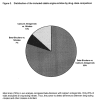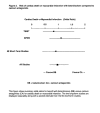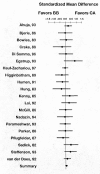NCBI Bookshelf. A service of the National Library of Medicine, National Institutes of Health.
Heidenreich PA, McDonald KM, Hastie T, et al. An Evaluation of Beta-Blockers, Calcium Antagonists, Nitrates, and Alternative Therapies for Stable Angina. Rockville (MD): Agency for Healthcare Research and Quality (US); 1999 Nov. (Evidence Reports/Technology Assessments, No. 10.)
This publication is provided for historical reference only and the information may be out of date.
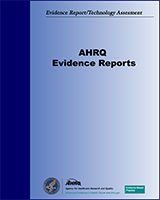
An Evaluation of Beta-Blockers, Calcium Antagonists, Nitrates, and Alternative Therapies for Stable Angina.
Show detailsTraditional Therapies
A total of 3,501 articles were identified with the MEDLINE and EMBASE searches and citation review.
Excluded Studies
We excluded articles using a hierarchical method beginning with 1,926 studies that were not trials of anti-anginal medications in stable angina patients (Figure 1). Another 959 studies were excluded because they compared a single drug with placebo. An additional 255 studies were intraclass comparisons (e.g., different beta-blockers compared) and thus were excluded. In 78 studies a new drug was added to background therapy without a drug-drug comparison. We excluded 77 studies because they evaluated anti-anginal drugs other than nitrates, beta-blockers, or calcium antagonists. Another 54 studies were excluded because the study duration was less than 1 week. Seventeen articles were duplicate reports or substudies of an included study, and nine evaluated medication withdrawal as the intervention. We excluded 25 studies that may have fulfilled the inclusion criteria but were written in a language other than English. Six trials were excluded because a study drug was required during the run-in period prior to randomization. Five articles did not report any of the primary outcomes (angina, nitroglycerin use, exercise time, adverse events, cardiac death, or myocardial infarction). The remaining 90 articles were abstracted (Evidence Tables 1-21). The MEDLINE search identified 86 articles (96 percent); EMBASE identified one that MEDLINE did not; and the citation search identified three not found in our MEDLINE or EMBASE searches.
Beta-Blockers Versus Calcium Antagonists: Study Characteristics
The majority of studies (n = 72) compared beta-blockers with calcium antagonists (Figure 2). The mean age of enrolled patients was 57 years; 84 percent were male; and 35 percent had a history of myocardial infarction. The included studies had a median length of 4 weeks (interquartile range 3-6 weeks), and only two trials (Dargie, Ford, and Fox, 1996; Rehnqvist, Hjemdahl, Billing, et al., 1996) lasted longer than 6 months.
A majority of studies (64, 89 percent) required evidence of coronary artery disease or ischemia in addition to a history of stable angina. A positive treadmill test was required in 57 trials. Exclusion criteria were mentioned in 56 of the reports and included congestive heart failure (46 studies), recent myocardial infarction (45 studies), bradyarrhythmia or heart block (31 studies), significant lung disease (26 studies), and diabetes mellitus (13 studies). The trials were predominantly crossover in design (49 studies), and the majority were conducted in Europe (50 studies) or North America (16 studies). Funding sources were stated in 31 studies; of those, 45 percent (14) received support from the pharmaceutical industry. Significant differences in the abstracted outcome measures between beta-blockers and calcium antagonists were reported in only 17 of 72 trials. Fifty-six trials were both double-blind and randomized (Evidence Table 19).
Cardiac Death or Nonfatal Myocardial Infarction
Only two trials (Dargie, Ford, and Fox, 1996; Rehnqvist, Hjemdahl, Billing, et al. 1996) were long-term (> 6 months) comparisons of beta-blockers and calcium antagonists. These two studies accounted for 103 of the 116 cardiac events (cardiac deaths or nonfatal myocardial infarctions) recorded in all trials (Evidence Table 22, Figure 3). The pooled odds ratio of these two trials for risk with beta-blockers was 0.98 (0.66,1.47). For the 59 short-term trials, there was no obvious difference in cardiac death or myocardial infarction, odds ratio 0.90 (0.40, 2.00). When both long- and short-term trials were combined (Table 1), the odds ratio for risk with beta-blockers was 0.97 (0.67,1.38). A random-effects model produced similar results: 0.98 (0.67, 1.43). No significant differences were found when the trials were grouped by type of calcium antagonist (nifedipine vs. non-nifedipine) or calcium antagonist duration of action (Figures 4a and 4b).
Table
Table 1. Beta-blockers vs. calcium antagonists: Outcomes in stable angina.

Figure
Figure 4a. Risk of cardiac death or myocardial infarction with beta-blockers compared to subgroups of calcium antagonists. BB = beta-blocker; CA = calcium antagonists
Angina Episodes
Patients enrolled in the trials that compared beta-blockers with calcium antagonists had moderately frequent angina with 4.0 ± 5.9 episodes per week during treatment (Evidence Table 23, Figure 5). When compared with calcium antagonists, beta-blockers were associated with 0.31 (0.00, 0.62) fewer episodes of angina per week. When the comparison was restricted to trials comparing beta-blockers with nifedipine, there were 0.63 (0.21, 1.0) fewer angina events per week with beta-blockers (Figure 6a). We did not observe a significant effect on the duration of action of calcium antagonists when the short-acting and long-acting calcium antagonists were compared separately with beta-blockers (Figures 6a and 6b).
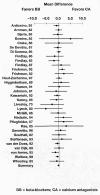
Figure
Figure 5. Beta-blockers vs. calcium antagonists: Angina episodes per week. This figure shows the difference in angina episodes per week between beta-blockers (BB) and calcium antagonists (CA).

Figure
Figure 6b. Differences in exercise time between beta-blockers and subgroups of calcium antagonists.
Nitroglycerin Use
Despite the differences in the frequency of angina, nitroglycerin tablet use per week was not significantly different between patients treated with beta-blockers and patients treated with calcium antagonists (Table 1, Evidence Table 24, Figure 7). There was a nonsignificant reduction of 0.14 (-0.19, 0.46) fewer nitroglycerin tablets per week with beta-blockers in those studies that compared beta-blockers with nifedipine. We observed no differences when short-acting and long-acting calcium antagonist preparations were examined separately.
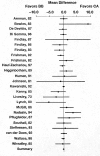
Figure
Figure 7. Beta-blockers vs. calcium antagonists: Nitroglycerin use per week. This figure shows the difference in nitroglycerin use per week between beta-blockers (BB) and calcium antagonists (CA).
Exercise Time
Exercise test protocols varied widely across studies. Therefore, we used a standardized mean difference where the mean difference in exercise time is expressed as a fraction of the standard deviation (Evidence Table 25). There was slightly greater total exercise time with calcium antagonists compared with beta-blockers (Table 1). However, there was no significant difference in time to 1-mm ST depression (ischemia) between calcium antagonists and beta-blockers (Table 1, Figure 8). Similarly, no difference in exercise time to ischemia was observed when only trials comparing beta-blockers with nifedipine were evaluated (Figure 6b). No differences were noted when short-acting and long-acting preparations of calcium antagonists were evaluated separately.
Adverse Events Leading to Withdrawal
Adverse events that led to study withdrawal occurred in 8 percent of patients (Evidence Table 26). Patients were less likely to discontinue beta-blockers than calcium antagonists in the 46 studies that compared these agents, odds ratio 0.72 (0.60, 0.86) (Figure 9). The absolute difference in the adverse event rate was 2.0 (0.5, 3.4) fewer events with beta-blockers compared with calcium antagonists for every 100 patients treated.
Trials comparing nifedipine with beta-blockers had significantly fewer adverse events with beta-blockers, odds ratio 0.60 (0.46, 0.77) (Figures 4a and 4b). In contrast, there was no significant difference in the rate of adverse events between non-nifedipine calcium antagonists and beta-blockers. Adverse events were not significantly different between long-acting and short-acting calcium antagonists when these agents were compared separately with beta-blockers (Figures 4a and 4b).
Side Effects
The total number of side effects with each drug was not reported consistently. However, we identified five categories of side effects that were commonly reported (increasing angina, gastrointestinal disturbances, peripheral edema, headache, and other CNS disturbances). There were 20 studies comparing beta-blockers with calcium antagonists that reported at least one of these side effects (Evidence Table 27). These trials included 1,175 patients treated with beta-blockers and 1,155 patients treated with calcium antagonists. There were 118 side effects (10 percent) in the beta-blocker group and 161 (14 percent) in the calcium antagonist group. Patients treated with calcium antagonists compared with those given beta-blockers reported headache more often (48 vs. 27), more frequent gastrointestinal disturbance (60 vs. 38), and more episodes of peripheral edema (24 vs. 2) than patients treated with beta-blockers. There were no clear differences between calcium antagonists and beta-blockers for the side effects of worsening angina (25 vs. 28) and other nonheadache CNS disturbances (21 vs. 23). Sexual dysfunction was reported in two trials (Rehnqvist, Hjemdahl, Billing, et al., 1996; Wallace, Wellington, Chess, et al., 1994), and the number of patients reporting sexual dysfunction (five) was similar for beta-blockers and calcium antagonists.
When we examined individual calcium antagonists, both verapamil and nifedipine had more side effects than the beta-blockers with which they were compared. There were 76 verapamil side effects in 508 patients treated with verapamil (six trials), compared with 47 side effects in 512 patients treated with beta-blockers. There were 56 nifedipine side effects in 380 patients treated with nifedipine (eight trials) compared with 44 beta-blocker side effects in 397 patients treated with beta-blockers. Too few data were available for diltiazem (four trials, 124 patients) to draw conclusions. Peripheral edema was more common with nifedipine (16 vs. 0 with beta-blockers) and diltiazem (4 vs. 0 with beta-blockers). Headache was also more common with nifedipine (26 vs. 11 with beta-blockers), while gastrointestinal disturbance was more frequent with verapamil (43 vs. 15 with beta-blockers) and diltiazem (4 vs. 0 with beta-blockers).
Secondary Analyses
When we limited the trials to those that studied the four most commonly used calcium antagonists and the five most commonly used beta-blockers, we noted significantly fewer angina episodes per week, odds ratio 0.40 (0.05, 0.75), and fewer adverse events, 0.73 (0.59, 0.92) for beta-blockers compared with calcium antagonists. No significant differences in any of the outcome measures were found when the trials were grouped by funding source or study location. Similar results were found when trials of crossover and parallel design were evaluated separately.
We separated trials into high (randomization and double blinding stated) and low (both not stated) quality. Separate analyses of high- and low-quality studies demonstrated similar results.
We compared beta-blockers with dihydropyridine calcium antagonists (nifedipine n = 26, nicardipine n = 5, amlodipine n = 1, felodipine n = 1) separately and found fewer adverse events, odds ratio 0.63 (0.49, 0.80), and angina episodes per week, 0.61 (0.23, 0.99) with beta-blocker therapy. However, nifedipine accounted for 79 percent of all dihydropyridines, and an effect of dihydropyridine therapy independent of nifedipine could not be demonstrated.
Long-Acting Nitrates Versus Calcium Antagonists
Twelve studies compared calcium antagonists with long-acting nitrates (Table 2, Evidence Tables 28-33, Figures 10-12). Patient characteristics were similar in trials previously described comparing beta-blockers and calcium antagonists. There were no significant differences in outcomes between these classes of medications; however, a trend ( p = 0.1) was noted for greater number of angina episodes per week in patients who were taking long-acting nitrates.
Table
Table 2. Nitrates vs. calcium antagonists: Outcomes in stable angina.
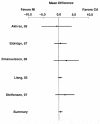
Figure
Figure 10. Nitrates vs. calcium antagonists: Angina episodes per week. This figure shows the difference in angina episodes per week between long-acting nitrates (NI) and calcium antagonists (CA).
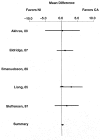
Figure
Figure 11. Nitrates vs. calcium antagonists: Nitroglycerin use per week. This figure shows the difference in nitroglycerin use per week between long-acting nitrates (NI) and calcium antagonists (CA).
Long-Acting Nitrates Versus Beta-Blockers
Only six studies compared beta-blockers with long-acting nitrates (Table 3, Evidence Tables 34-39, Figures 13,14). Patient characteristics were similar in trials that compared beta-blockers with calcium antagonists. There were no significant differences between beta-blockers and long-acting nitrates in any of the outcomes measured. A trend ( p = 0.08) toward increased nitroglycerin use per week was noted for patients who were taking long-acting nitrates.
Table
Table 3. Beta-blockers vs. nitrates: Outcomes in stable angina.
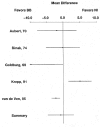
Figure
Figure 13. Nitrates vs. beta-blockers: Angina episodes per week. This figure shows the difference in angina episodes per week between long-acting nitrates (NI) and beta-blockers (BB).
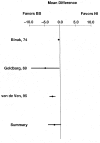
Figure
Figure 14. Nitrates vs. beta-blockers: Nitroglycerin use per week. This figure shows the difference in nitroglycerin use per week between long-acting nitrates (NI) and beta-blockers (BB).
Effect of Excluding Non-English Articles
To determine the effect of excluding articles that were written in languages other than English, we reviewed the abstracts (in English) that were available for 12 studies (50 percent) whose full text was not written in English. None of the studies reported a significant difference in death or myocardial infarction rates, exercise time, angina episodes, or nitroglycerin use for comparisons between beta-blockers and calcium antagonists (n = 6), beta-blockers and nitrates (n = 2), or calcium antagonists and nitrates (n = 4). Two of the studies that compared calcium antagonists and nitrates noted fewer side effects with calcium antagonists.
Alternative Medicine for Stable Angina
We identified 18 trials of alternative therapies used for patients who had stable angina. We excluded two studies that were not randomized and four studies of herbal medications that used another herbal therapy as a control. The remaining 12 articles included four of acupuncture (three English, one Chinese language) (Ballegaard, Meyer, and Trojaborg, 1991; Ballegaard, Pedersen, Pietersen, et al., 1990; Richter, Herlitz, and Hjalmarson, 1991; Zhou and Liu, 1993) and eight of herbal therapy (one English, seven Chinese language) (Cai, Xu, and Shen, 1996; Chen, Zhou, and Gao, 1996; Fang, Jiang, and Luo, 1987; Liao, Chen, Wu, et al., 1989; Wang, Shi, and Tu, 1996; Wu, 1990; Zhang, Liang, and Ma, 1995; Zhu, 1994). There were no randomized trials of garlic or chelation therapy in patients with stable angina. Our review was limited to those studies with at least an abstract written in English (all four acupuncture, seven herbal articles).
Three trials randomized patients to acupuncture or sham acupuncture, in which needles are not placed at traditional points (Ballegaard, Meyer, and Trojaborg, 1991; Ballegaard, Pedersen, Pietersen, et al., 1990; Zhou and Liu, 1993). No significant differences were noted in angina episodes or nitroglycerin use; one study, however, noted increased work capacity in patients randomized to acupuncture. The fourth study (Richter, Herlitz, and Hjalmarson, 1991) noted reduced angina and increased time to angina with exercise for patients treated with acupuncture compared with placebo.
Of the seven Chinese herbal articles, six provided abstracts in English (Cai, Xu, and Shen, 1996; Chen, Zhou, and Gao, 1996; Wang, Shi, and Tu, 1996; Wu, 1990; Zhang, Liang, and Ma, 1995; Zhu, 1994). The controls used in these trials were dipyridamole and aspirin (n = 2), nifedipine (n = 1), isosorbide dinitrate (n = 1), and unstated (n = 1). Four trials (80 percent) reported significantly lower angina (Cai, Xu, and Shen, 1996; Wang, Shi, and Tu, 1996; Wu, 1990; Zhu, 1994), and one reported decreased ST depression during exercise in patients randomized to herbal therapy (Zhu, 1994). In the one herbal trial published in English, 32 patients were randomized to either an intravenous combination of radix ginseng, radix astragali and radix angelicae sinesis, or 10 percent dextrose. Both therapies were given as daily infusions for 2 weeks (Liao, Chen, Wu, et al., 1989). Significant improvements in angina and exercise endurance and ST depression were noted in the herbal group.
- Results - An Evaluation of Beta-Blockers, Calcium Antagonists, Nitrates, and Alt...Results - An Evaluation of Beta-Blockers, Calcium Antagonists, Nitrates, and Alternative Therapies for Stable Angina
- Acknowledgments - Rehabilitation for Traumatic Brain InjuryAcknowledgments - Rehabilitation for Traumatic Brain Injury
- Mouse DNA sequence from clone RP23-227I2 on chromosome 4, complete sequenceMouse DNA sequence from clone RP23-227I2 on chromosome 4, complete sequencegi|20177288|emb|AL669949.11|Nucleotide
- RecName: Full=CAAX prenyl protease 1 homolog; AltName: Full=Farnesylated protein...RecName: Full=CAAX prenyl protease 1 homolog; AltName: Full=Farnesylated proteins-converting enzyme 1; Short=FACE-1; AltName: Full=Prenyl protein-specific endoprotease 1; AltName: Full=Zinc metalloproteinase Ste24 homologgi|78099980|sp|Q80W54.2|FACE1_MOUSEProtein
Your browsing activity is empty.
Activity recording is turned off.
See more...

